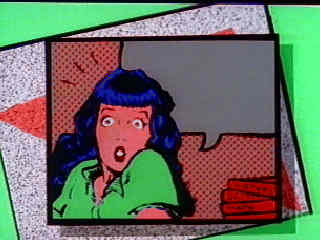
A glint of white showed under the clogged gray irises [of character Carmen Sternwood's panic-stricken eyes as private-eye Philip Marlowe questioned her about the night before." --The Big Sleep (Chandler 1939:65)
Facial expression. 1. An involuntary and dramatic widening of the eyes, performed in situations of intense emotion, such as anger, surprise, and fear. 2. A maximal opening of the eyelids (or dilation of the palpebral fissure) which shows the roundness and curvature (i.e., protrusion) of the eyeballs.
Usage: When we are truly surprised, rather than feigning the emotion for effect, as, e.g., in a conversation, two involuntary visceral muscles in our eyelids--the superior and inferior tarsals--widen our eye slits to make the eyes appear noticeably rounder, larger, and whiter. Like dilated pupils (another visceral sign of emotional arousal), flashbulb eyes are controlled by impulses from the nervous system's fight-or-flight division. As visceral signs, true flashbulb eyes are difficult to produce at will. Thus, they are all the more trustworthy as nonverbal cues, especially of terror or rage. In angry individuals, flashbulb eyes are a danger sign of imminent verbal aggression or physical attack.
Media. In the Dracula movies (e.g., of 1931, 1973, and 1979), actors Bela Lugosi, Jack Palance, and Frank Langella consciously widened their eyes before biting their victims' necks to draw blood. Had they felt true emotion, their eyes would have opened wider still.
RESEARCH REPORTS: 1. Exaggerated wide-eyes are included as items for surprise in the Facial Affect Scoring Technique (FAST; Ekman, Friesen, and Tomkins 1971). 2. In the stare, ". . . the eyelids are held wide open, exposing a greater area of eyeball than in the usual open position" (Brannigan and Humphries 1972:59).
Neuro-notes. Though we may consciously widen our eyes, maximal dilation of the eye slit enlists contractions of the tarsal muscles. These involuntary muscles of the upper and lower eyelids are innervated by the sympathetic (i.e., fight-or-flight) division of the autonomic nervous system, working through the superior cervical ganglion. Thus, in staring, e.g., anger is expressed by unwittingly widened eyes.
See also SWEATY PALMS.
YouTube Video: How to Draw a Flashbulb Eye
Copyright 1998 - 2016 (David B.
Givens/Center for Nonverbal Studies)
Picture credit: public domain clip-art image